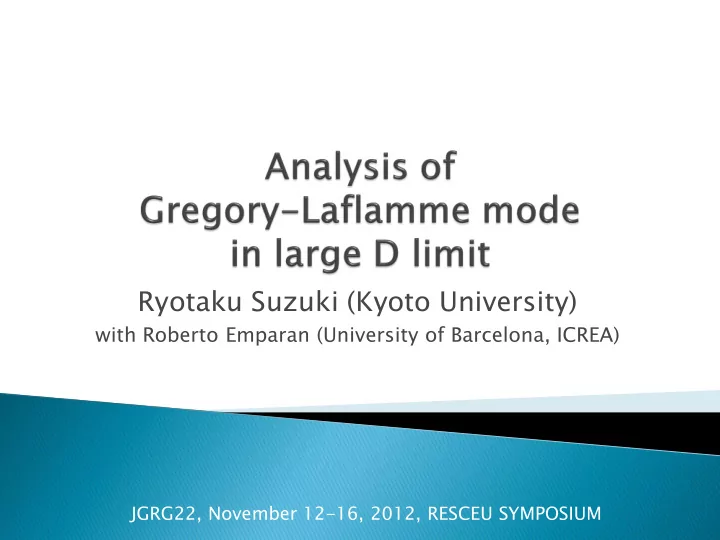

Ryotaku Suzuki (Kyoto University) with Roberto Emparan (University of Barcelona, ICREA) JGRG22, November 12-16, 2012, RESCEU SYMPOSIUM
1. Introduction 2. Large D limit 3. Dispersion relation 4. Summary
1. Introduction 2. Large D limit 3. Dispersion relation 4. Summary
Why y higher r dimension nsion ? String theory spacetime dimension > 4 -Various compactification -Large extra dimension higher dimensional gravity Black ck hole in Higher r Dimensio nsion No uniqueness, No topology theorem -Black String, Brane ( KK spacetime ) - Black Ring, Black Saturn, etc… Gregory ry-Laflam flamme Instabil abilit ity Characteristic in extended black object ( sting, brane ,…) Long wave length instability ~ hydrodynamic instability 1/10
In 1993, Gregory and Laflamme found a long wave length instability of black string (brane) Gregory, Laflamme, 1994 threshold : thickness ~ wave length Importanc ance -Universal property for extended objects -Determine Phase Diagram in KK spacetime UniformBS – NUBS – (caged) Black hole 2/10
1. Introduction 2. Large D limit 3. Dispersion relation 4. Summary
Numerical Analys ysis Sorkin (2004) studied the threshold mode numerically up to D=50 and observed dimensionless mass Large ge D limit Kol, Sorkin(2004), Asnin, et.al.(2007) solved analytically the threshold mode in large D limit agree with Sorkin(2004) Matched d asymptotic otic expansion on new coordinate near horizon expand with1/n asymptotic expand with 3/10
Camps et.al(2010) studied the instability in long wave length limit Narvier-Stokes Eq. +viscosity dispersion relation valid up to k^3 highly coincident with numerical data even k is large ! they proposed at large D Camps, Emparan, Nidal (2010) Question estion Can we prove this dispersion relation analytically ? 4/10
1. Introduction 2. Large D limit 3. Dispersion relation 4. Summary
n = D - 4 Large D Large n Black k String g backgrou ound Scalar Perturbati tion on with Transve verse-Traceless gauge Master r equation ion for Assumption Same equation in GL94 5/10
“Good” coordinate in Large D (used in Asnin et. al. (2007)) the effect of the horizon correctly incorporated at large D expansion up to 1/n leading g solution tion in asymptotic region require up to 6/10
Leadin ing g order f(r) 1 Expansion with regularity at the infinity modified Bessel of 2 nd kind Next to Leadin ing modified Bessel Eq. with source term Using Green function just contribute to ovarall scaling (up to 1/n) 7/10
Asymptotic solution Leading at near horizon Sub-leading at near horizon and 8/10
At X -> 1, the regular solution is large n limit matched solution Leading g order matching Expected growing mode !! 9/10
1. Introduction 2. Large D limit 3. Dispersion relation 4. Summary
We analytically solved the scalar perturbation on black brane in large D limit and obtained the expected dispersion relation. Our calculation shows that large D expansion should be useful analytic approximation in higher dimension. Application to another situation seems possible in the similar way. 10/10
Master Eq has a singular point between horizon and the infinity We first attempted to do matching at the singular point as Kol, Sorkin (2004) B.C LO trivial. NLO trivial… trivial……. NNLO
As B.C. for asymptotic sols, Kol,Sorkin(2004) used because master Eq. is singular at they say since But, since 1/r^n ~ 1/n at r_s, NLO should affect the matching. We calculated the next order and … Trivial matching !! canceled coincidence or reflecting some physics ?
Recommend
More recommend